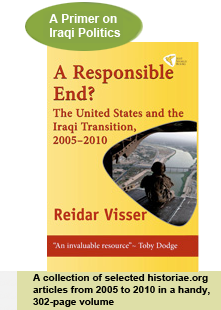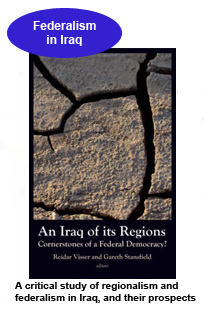



| Main | |
| Documents & images | |
| Links | |
| Contact | |
 | |
| amazon.com |

|
|
|
amazon.com
amazon.co.uk |
|

|
|
|
amazon.com
amazon.co.uk |
|
Towards Sectarian Separatism in Iraq?
By Reidar Visser (http://historiae.org)
13 December 2005
Kazimayn: the centre of Iraq – or the northern edge of a separate Shiite state?
Photo from the late British mandate period
Threats to Iraq’s territorial integrity are as old as the state itself. Kurdish demands for autonomy go back almost a century. Secular Basra leaders challenged the monarchy during the 1920s through a bid for a cosmopolitan city-state republic. There were even plans for a Christian enclave in northern Iraq in the interwar period.
Missing from this list is a scheme for a sectarian Shiite breakaway state. Even though outsiders frequently dreamt of this kind of scenario, the Iraqi Shiites themselves, throughout the twentieth century, appeared disinterested.
With one exception, that is. It occurred in 1927. After a savage clash between worshippers and Iraqi soldiers at Kazimayn, Shiite politicians whipped up a surge of sectarian discontent. At secret meetings, whispers of a Shiite state stretching from Baghdad to the Gulf were heard. But in the end, the attempt at separation proved abortive. The leading Shiite clergy rebuked the hot-headed radicals. One year later, the whole episode was forgotten.
The movers behind the Shiite separatist scheme were a diverse coalition. Some were disgruntled tribal leaders. Some were impoverished lower-rank clerics. The principal figure was Amin al-Charchafchi, a layman from a Baghdad merchant family, with strong links to the ulama. He may not have been the separatist architect, but his ability to gain access to the top clerics was all-important. At one point, he was close to securing their support.
Is the Charchafchi phenomenon present in Iraqi politics in 2005?
The most obvious parallel is the ongoing campaign for a single Shiite federal entity from Karbala to Basra. Launched last summer, this project uses sectarian identity to push for the unification of all provinces south of Baghdad. It has largely supplanted earlier Shiite calls for a federal Iraq with smaller, non-sectarian units. Ironically, it seems as if the long-suffering Shiites are succumbing to sectarianism just as their prospects for securing a fair share of government in a democratic Iraq look brighter than ever.
The similarities to 1927 are numerous. Also today’s movement is headed by professional politicians, not by the upper ranks of the clergy. Just like Charchafchi in 1927, these leaders have immense organisational skills. And like him they have no scruples about using sectarianism to boost their influence. With determination they approach the leading ayatollahs to elicit some sort of approval for their projects – and any signs of approval, however hesitant, are in turn employed to convince electors that they have a religious duty to give their support. The continuing terror attacks and anti-Shiite propaganda by Sunni Islamists can only fuel tensions; this echoes the harsh strictures on Shiite heritage by Sunni intellectuals seen in 1927.
The pro-federal Shiite politicians do not themselves promote separatism. Their own personal motives may be perfectly all-Iraqi. It is those on the fringes that challenge Iraq’s territorial integrity. It is they who write on the internet about a single Shiite state from Samarra to Basra. It is they who see the pro-Shiite but technically multi-sectarian election ticket of the United Iraqi Alliance as essentially a "United Shiite Alliance". And it is they who are inclined to find inspiration in pamphlet literature where schemes for a "Shiite federalism" that would combine both Iran and Iraq are outlined.
The politicians’ role is to build bridges between the higher clergy and grassroots radicals. In this they are astonishingly successful. Every single public statement by Grand Ayatollah Ali al-Sistani shows that the he is deeply concerned about the territorial integrity of Iraq and the dangers of sectarian warfare. And yet Shiite professional politicians somehow manage to maintain cordial relations with Sistani while at the same time pursuing policies that directly – if unintentionally – threaten the very unity so dear to Iraq’s leading cleric. The most recent example is the last-minute green light from Najaf for a "yes" vote to the new Iraqi constitution – a document devoid of real checks and balances against the forces of fragmentation. This sort of leeway is what Amin al-Charchafchi failed to achieve when he approached the ulama in 1927.
The upcoming elections may prove decisive. Sectarianist factions among the Shiite Islamists persuaded the United States to accord them privileged status during the exile opposition meetings. They tenaciously held on to this position after the war, and translated it into electoral success last January by joining the "Sistani list" – so named after its assumed but taciturn sponsor. Today, they are again part of a wider Shiite coalition that frequently alleges it enjoys the top clergy’s exclusive endorsement (but has yet to produce a fatwa or other unequivocal, signed and sealed statement to that effect). Will Iraqi electors once more allow these politicians a monopoly on expounding Sistani’s reticent communications? Will those agitators themselves realise that their present course poses risks to the proud anti-sectarian tradition of Iraq’s Shiites? Such issues could determine whether Shiite separatism again gets relegated to parenthesis status in Iraqi history – or is transformed into a major theme.
(This comment article is based on the recently published book Basra, the Failed Gulf State: Separatism and Nationalism in Southern Iraq by Reidar Visser.)
.
This document may be freely reproduced as long as http://historiae.org is credited as the source.
